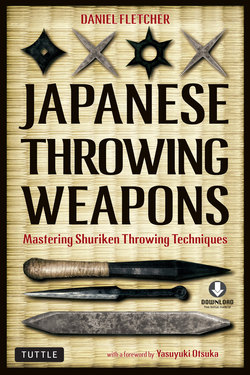Читать книгу Japanese Throwing Weapons - Daniel Fletcher - Страница 6
На сайте Литреса книга снята с продажи.
ОглавлениеForeword
In this book, you will be receiving valuable instructions on the Japanese martial art of shuriken-jutsu. The author, Danny Fletcher, is my student and has studied shuriken-jutsu directly under me in Japan. I have been teaching and guiding students of shuriken-jutsu for about 25 years. It was fortunate for him that I had a web site for the Meifu-Shinkage Ryu since 1999. In May 2004, he sent me an e-mail and came to Tokyo from Funabashi to meet me.
Danny said to me that he had lived in Japan several years, and was studying another martial art already. In addition to his learning other martial arts, he was hoping to master Japanese shuriken-jutsu. So, I explained to him about Meifu Shinkage Ryu shuriken-jutsu. In addition to speaking with him, I demonstrated our shuriken-jutsu methods. It seemed that my demonstration impressed him, because that same day he be came one of my students.
After entering Meifu Shinkage Ryu, he trained diligently at every class. To my surprise, he was very familiar with Japanese martial arts. He has con siderable knowledge about ken-jutsu, ju-jutsu, and other arts. He said he was really surprised to see someone throw a shuriken at such long distances or throw them so fast.
Even here in Japan, there are very few people who have knowledge of shuriken-jutsu. In Japan, the birthplace of shuriken-jutsu, there are few teachers of shuriken-jutsu who can teach their students properly. There are probably fewer than five such men.
My teacher, Mr. Chikatoshi Someya, was the founder of the Meifu Shinkage Ryu. Someya Sensei was a master of Katori Shinto Ryu. Katori Shinto Ryu is a classical Japanese martial art (Ko-budo). After studying for many years, he established his own school that teaches shuriken-jutsu. This was in the 1960’s and he named his school the Meifu Shinkage Ryu. (MSR)
He wrote a book about his studies of shuriken-jutsu, and opened a dojo to the public. It was a revolutionary event in Japanese antique budo (martial arts). Classical martial artists don’t usually offer to teach their techniques to the public, especially shuriken-jutsu, which was considered a secret weapon for hundreds of years. So, there is very little research material about shuriken-jutsu in Japan. This is also the reason why there are so very few shuriken-jutsu teachers. Someya Sensei was very disappointed with those circumstances. He was afraid that the art of shuriken-jutsu might die and become a forgotten part of Japanese history. Therefore, he taught the previously secret shuriken-jutsu to the public.
I joined his shuriken school in 1984 after reading his book. After joining the Meifu Shinkage Ryu, I practiced earnestly and became a master after ten years. To my regret, Someya Sensei passed away in 1999, but I was appointed his successor during his lifetime. I succeeded my teacher’s instruction, and decided to continue to pursue his dream of preserving this art.
I set up my web site on the Internet and began sending information about shuriken-jutsu to not only Japan, but also the world. In 2004, I published a book and a DVD. As time went on, my efforts began to pay off, there were many people sending me e-mails from a dozen different countries. Some of them visited me and became my students. Danny Fletcher was one of them.
Danny is a very large man from a Japanese point of view. When I compared the size of my hands with his, I suggested that he use an extra-long shuriken. He is large, but the principles of shuriken-jutsu don’t change. I treated him the same way as any Japanese student except for the size of his shuriken. Now, he uses regular-sized shuriken.
Meifu Shinkage Ryu at Katori Shrine in Japan
Of course, our linguistic differences sometimes caused a little difficulty in teaching, but it was not a big problem for us. Shuriken-jutsu can’t be ex plained just in words. If you learn old Japanese martial arts, you must observe your teacher’s movement.
Danny observed my shuriken-jutsu very carefully and understood the meaning. After about three years of training with me, he acquired his sho-dan (black belt). He understands the essence of shuriken-jutsu. Now, he is back in his home in Texas, and has completed this book. This is the result of Danny’s hard training in Japan. Anyone who has an interest in the ancient Japanese martial arts should read this book.
There is something important I want to share with you. My teacher, Someya Sensei, gave this to me. All students of the Meifu Shinkage Ryu should understand this admonition:
You must not become attached to the idea of piercing the target.
If you do, you may desire more targets to pierce.
The heart that desires a target is the same as the heart that desires an enemy.
Desiring an enemy is foolishness.
Foolishness is the darkness of your heart.
If you live sincerely, your heart will hold no shadows.
If your heart and deeds are pure, then you will never encounter an enemy.
Then, time and distance are transcended and you will defeat any enemy.
This is “Shin-da.” (Truly pierced.)
Yasuyuki Otsuka.
Headmaster of Meifu Shinkage Ryu.
2011
(See page 115 for original Japanese text of this creed.)
